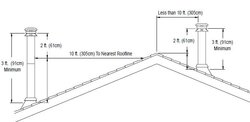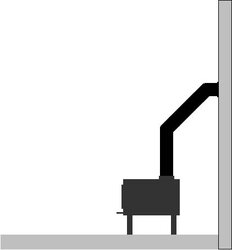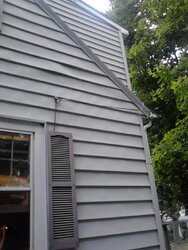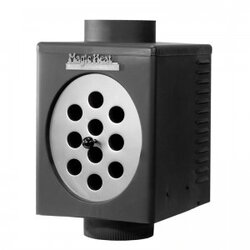Hello all, nice forum you all have here. I was just hoping someone could give me a bit of guidance. I have been recently interested in installing a wood stove in my home. I am thinking about putting one in my dining room corner as it should direct heat good throughout the entire house. My biggest question is the chimney. I have no access to tap into the existing one so a new one would be needed on this side of the house. I have a two story house and this will be on the main floor. Is it advisable to go out a wall and up the side of the house? I would assume this needs to terminate above the roof? The height of the chimney seems it would be pretty expensive..... what materials would I need starting at the stove? Thanks for the tips. Colin.
Considering a wood stove.
- Thread starter ColinM
- Start date
-
Active since 1995, Hearth.com is THE place on the internet for free information and advice about wood stoves, pellet stoves and other energy saving equipment.
We strive to provide opinions, articles, discussions and history related to Hearth Products and in a more general sense, energy issues.
We promote the EFFICIENT, RESPONSIBLE, CLEAN and SAFE use of all fuels, whether renewable or fossil. -
Super Cedar firestarters 30% discount Use code Hearth2024 Click here
You are using an out of date browser. It may not display this or other websites correctly.
You should upgrade or use an alternative browser.
You should upgrade or use an alternative browser.
- Status
- Not open for further replies.
The chimney can cost as much as the stove in some cases. It's often expensive to go straight up through the house and then box around the pipe on the second floor or run it in a closet as long as clearances are honored.
In order to educate yourself, you might want to go to a good fireplace/wood stove store like Top Hat (south part of Madison) or if there's a place like that around Janesville, and get an estimate. During my last project, Top Hat came out to my house for something called a "preview" and gave me an estimate of what things would cost for a particular stove/chimney to be installed by Top Hat. They look for the best place to install it and will give you an idea of the recommended materials to be used.
CLVTCH
New Member
In order to educate yourself, you might want to go to a good fireplace/wood stove store like Top Hat (south part of Madison) or if there's a place like that around Janesville, and get an estimate. During my last project, Top Hat came out to my house for something called a "preview" and gave me an estimate of what things would cost for a particular stove/chimney to be installed by Top Hat. They look for the best place to install it and will give you an idea of the recommended materials to be used.
That sounds like some great service right there. Up here I got to order what I wanted from a catalog, sight unseen and definitely no site visits for advice without paying them $150/hour to do so.
If you are still in "consideration" mode - also consider the work that goes along with making fire. Storage, access, movement, etc. I know that this gets thrown around quite a bit, but it really is a "life style". If it still sounds good, then by all means proceed.
According to the OP this will be a new chimney. The height will be determined by its location relative to the roof. The chimney must end at least 3' above the roof and at least 2' above any portion of the roof within 10'. Figure a minimum of 15' of total flue height (including stove connector) if below a couple thousand feet in altitude. 90 degree turns rob some of the draft velocity. For rough figuring you can approximate each 90 deg turn in the smoke path as costing about 2-3ft of vertical height. Some will add another length of chimney to compensate. Or, if the overall height is marginal, the tee can be connected using a pair of 45s with a short offset to soften the angle.




Thanks for all the great tips everyone! I really appreciate it. I do see that burning wood will be a lot of work but I'm the type who likes to tinker! For the first year I'm sure I will be buying wood but in time I think id find cheaper alternatives. I really like the idea of having a nice fire during the cold wisconsin winters! I am going to take my time with this and find what will work best for me. It looks like I would have to exit the dining room wall the turn up and go above the second story roof. Can anyone recommend a good system to use from the stove out? Are the stove pipes inside the house "usually black" insulated like the stainless ones I see on the outside of the home? Thanks again. Colin.
Stove pipe connector is used from the stove to the wall connection where it transitions via a thimble to class A, high-temp pipe. There are kits for this made by DuraVent and Selkirk. They are designed for conventional walls so be sure that the parts included solve your installation requirements. Will this be on the gable end of the house? How deep is the soffit?
If you have a Menards nearby, they may have the best deal.
http://www.menards.com/main/heating...rvent-6-wall-support-kit/p-1747020-c-6894.htm
http://www.menards.com/main/heating...rvent-6-wall-support-kit/p-1747020-c-6894.htm
That sounds like some great service right there. Up here I got to order what I wanted from a catalog, sight unseen and definitely no site visits for advice without paying them $150/hour to do so.
I was impressed, and I didn't even go with them. I went with their competitor who also gave a preview on the same day. I did use Top Hat for chimney cleaning services before I started doing my own, and they always gave good service. They sell Hearthstone, Jotul and a few other good brands. I ended up staying with Quadra-Fire.
When buying fire wood consider this- if a seller says it is seasoned chances are it is seasoned only with Bar oil and 2 stroke exhaust. In other words it ain't going to be dry enough to be properly burned in a current stove. Current stoves require a internal moisture content of 20% or less per split ( 15% being just about ideal). Best bet at this stage of the game is to get a pallet or more of the compressed wood blocks ( Menards has them) and mix with firewood in the stove. That gives a half a shot at getting a clean burn and decent heat output. In a few more weeks we will be seeing posts bemoaning poor heat output from new stove installs and the like. 98% of the time traceable to poor fuel ( insufficiently dried wood)
Yes, actually higher than the top of the bedroom addition to meet the 10-3-2 rule. Is there no chance of giving up a bit of bedroom space to run it straight up inside?
I actually wouldn't mind running it through the bedroom... that bedroom is horribly cold in the winter and that might help warm it? The bedroom is something like 15x20 so you wouldn't notice any room gone! I assume you would have to enclose the pipe? Would you use the same insulated pipe there or the stove pipe like off the stove?
Yes, it would help warm it a little. You would need to chase the pipe in the bedroom, but the chase could have vents top and bottom to let out some heat. This must be done with chimney pipe, the same that is used outside. Stove connector pipe would only be used up to the ceiling support box. Done right this will be a much better performing chimney, easy to clean and it should cost less too.
A chase is the box that surrounds the chimney pipe. Any wood framing or drywall must have at least 2" clearance from the chimney pipe at all points when building the chase.
Last edited:
I would suggest going to DuraVent's website and downloading the instruction manual for installing chimney pipe. It's a good document and will answer a lot of questions for you. Here is a link. Click on the "Literature" tab to find their installation instructions.
http://www.duravent.com/Product.aspx?hProduct=1
http://www.duravent.com/Product.aspx?hProduct=1
prezes13
Minister of Fire
View attachment 140060 How about that heat exchanger box would that help to heat that bedroom if it's a safe thing to do of course.
Was that a serious suggestion? Those "magic heat" contraptions are frowned upon here and for a reason. They reduce draft and cool down the flue gases, thereby creating tons of creosote. A chimney fire waiting to happen. A pain to clean in addition. Stay far away from those.
prezes13
Minister of Fire
Thankfully a Magic Heat can't be installed in chimney pipe. It is not needed or desirable with a modern stove and a creosote trap on an older stove.
- Status
- Not open for further replies.
Similar threads
- Replies
- 21
- Views
- 937
- Replies
- 13
- Views
- 1K
- Replies
- 66
- Views
- 5K
- Replies
- 7
- Views
- 977



